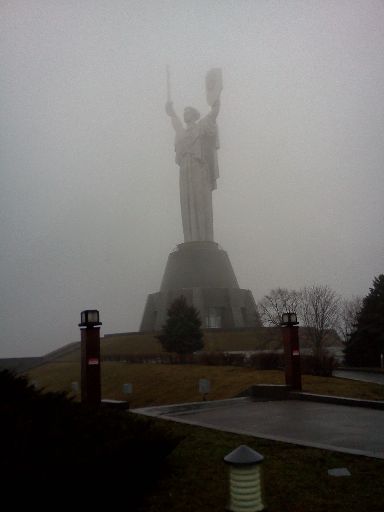Kyiv 2014
My trip to a post-revolutionary Ukraine
March 4 (Tuesday at 20th-century museums and monuments)
I'm not very good with jet lag. It's why I don't like short trips to Europe or Asia. So something low-key was best for this day. And I was glad to have help getting my phone to work, since putting minutes on my SIM card took four tries in four places before it finally took. The connection was 2G, and the connectivity was a little questionable after momentarily losing it, e.g., in the subway. But, in spite of all that, it was very useful to have the Internet at my fingertips in a foreign land (and, as I explained prior, fairly cheap, too).
I took the Metro to Arsenalna station; though the adjacent Dnipro station stands above the Dnieper, the height of the nearby slope means that Arsenalna might be the deepest Metro station in the world, depending on whom you believe. (North Korea has competing but unverified claims.) South of the city center, this is the station for several attractions, including a park containing memorials to Ukraine's greatest 20th-century tragedies. The war memorial, the northernmost of many in the area, has the Monument of Eternal Glory, marking their tomb of the unknown soldier, who died in WWII. Like those in other countries, this has an eternal flame, though this day it was barely visible in the fog. In addition to the unknown soldier are 34 named soldiers, whose tombstones lead up to the main monument.
 |
Nearby is the Holodomor memorial and museum. The Holodomor was the mass-starvation of the Ukrainian SSR implemented by Stalin in 1932-1933. Ukrainian products were imported to Western Europe to fund the Soviet system, while the resistance and nationalism was crushed at home by not allowing food to enter. Figures aren't certain, but most estimates are that between two and ten million people died, the most-cited estimate being near four million. Cannibalism and eating leaves and weeds were rampant. An exhibition room lies under the memorial, with many details in English, though it's hard to pick out an exact narrative, since there's much about this mass starvation which still remains unknown. Also scattered throughout the room were photos from Euromaidan. It's not hard to make the connection here, both being examples of Moscow trying to control Ukraine via indiscriminate killing, with some level of obfuscation and plausible deniability.
I assumed that this uncertainty and deniability explained why the small, free exhibit, though chronological, was nevertheless not what I'd call "narrative"; it was somewhat difficult to follow what followed what and why. I later found that this was a feature of all Kyiv museums — long on detail, short on narrative.
From there I walked past the Lavra — the thousand-year-old religious complex — and to the war museum complex. There sat tanks, planes, anti-aircraft weaponry, and all sorts of other equipment used by Ukrainian SSR in Soviet wars. Most of these were in a small, outdoor annex to the main path, a path on which one could hear Soviet military music through speakers on each side. A tunnel of Soviet sculpture led to the WWII museum — the Museum of the Great Patriotic War — which was housed under a huge statue, the Motherland Monument. It was large enough to be visible throughout much of Kyiv, but, due to the fog, there were times at which I couldn't see even its head while right in front of it.
 |
The museum itself had myriad artifacts and each room had a description in multiple languages of what was contained therein. If you knew Russian or Ukrainian, you could spend a whole day there looking at everything. With the data connection on my phone, I occasionally but slowly looked up what some things meant, such as the Soviet propaganda poster saying, "Fascism — that's war." And though I mostly refrained from doing that until I exited, even I, with my meager knowledge of Cyrillic and German, took longer than I might have expected, and was surprised to hear an announcement that the museum was closing, this when I hadn't yet finished the ground floor. I expected to be ushered out, but, thankfully, I was merely pointed to the upper floors; it seems they're less strict about closing time than their Western European counterparts. By the end, though, either jet lag or a day spent trying to read Cyrillic — or some combination thereof — had given me a huge headache.
Because by now I was far from any Metro station, I decided to walk down to and across the Dnieper. At first I was worried that there was no pedestrian walkway, but there was, a sidewalk between the oncoming traffic and the Soviet-era metalwork railing. The long bridge gave me time to notice license plates, and I noticed that they used only numbers and letters common to both Cyrillic and Latin alphabets. No "N"s or backwards "N"s. After crossing, I stopped at my first Ukrainian supermarket to get some things for Mila and myself. Mila later told me I'd gone to the "expensive" supermarket — its name actually translates to "banquet center" — though of course it wasn't expensive to me.